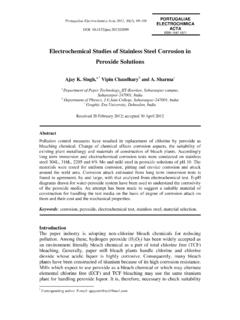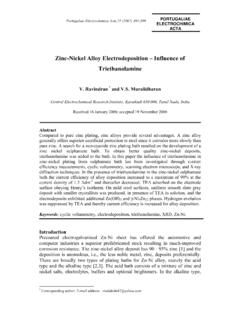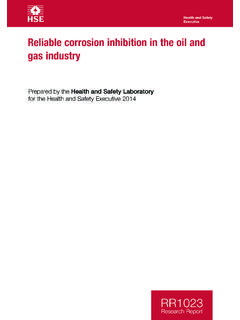Transcription of Pyrazole Derivatives as Corrosion Inhibitors for Steel in ...
1 Portugaliae Electrochimica Acta 26 (2008) 211-220 PORTUGALIAE ELECTROCHIMICA ACTA Pyrazole Derivatives as Corrosion Inhibitors for Steel in Hydrochloric Acid L. Herrag, A. Chetouani, S. Elkadiri, B. Hammouti,* A. Aouniti Laboratoire de Chimie Appliqu e & Environnement, Facult des Sciences, Universit Mohammed 1st, 60000 Oujda, Morocco Received 17 May 2007; accepted 9 August 2007 Abstract The effect of 1-{[benzyl-(2-cyano-ethyl)-amino]-methyl }-5-methyl-1H- Pyrazole -3-carboxylic acid methyl ester (P1) and 1-{[benzyl-(2-cyano-ethyl)-amino]-methyl }-5-methyl-1H- Pyrazole -3-carboxylic acid ethyl ester (P2) was evaluated as Corrosion Inhibitors of Steel in molar hydrochloric using weight loss measurements and electrochemical polarisation.
2 The results obtained reveal that those compounds reduce the Corrosion rate. The inhibiting action increases with the concentration of Pyrazole compounds to attain % at the 10-3 M of (P2). The increase in temperature leads to a decrease in the inhibition efficiency of the compounds in the temperature range 308 353 K. The adsorption isotherm of Inhibitors on the Steel has been determined. The thermodynamic data of activation and adsorption are determined. Keywords: Pyrazole , inhibition, Corrosion , Steel , acid.
3 Introduction Hydrochloric acid is commonly used in industrial processes like chemical cleaning and pickling to remove mill scales (oxide scales) from the metal surface. During this stage, the addition of inhibitor is necessary to avoid the attack of metal. Inhibitors should be effective even under severe conditions in concentrated acid (20%) and temperatures ranging from 60 to 95 C. The most efficient Corrosion Inhibitors used in chlorhydric acid contain heteroatoms such as sulphur, nitrogen and oxygen containing compounds [1-6].
4 * Corresponding author. E-mail address: L. Herrag et al. / Portugaliae Electrochimica Acta 26 (2008) 211-220 212 Survey of literature reveals that azole, azine and pyridine [7-9] compounds are effective Corrosion Inhibitors up to 80 C. The synthesis of new organic molecules offers various molecular structures containing several heteroatoms and substituants. Their adsorption is generally explained by the formation of an adsorptive film of a physical or chemical character on the metal surface [10-12].
5 The encouraging results obtained by pyrazolic compounds [13-17] have incited us to synthesize other compounds and to test their addition on the Corrosion behaviour of Steel in acidic media. In the present work, we investigate the Corrosion of Steel in 1 M HCl by 1-{[benzyl-(2-cyano-ethyl)-amino]-methyl }-5-methyl-1H- Pyrazole -3-carboxylic acid methyl ester (P1) and 1-{[benzyl-(2-cyano-ethyl)-amino]-methyl }-5-methyl-1H- Pyrazole -3-carboxylic acid ethyl ester (P2); weight loss and polarisation measurements have been used to study the effect of addition of these compounds on the Corrosion of Steel in HCl solution.
6 The effect of temperature is also studied and some thermodynamic parameters are evaluated. Experimental details Steel sample containing ; ; ; ; ; and the remainder iron. Prior to all measurements, the Steel samples are polished with different emery paper up to 1200 grade, washed thoroughly with bidistilled water degreased and dried with ethanol, acetone. The molar hydrochloric solution is prepared by dilution of Analytical Grad 97% HCl with bidistilled- water. Pyrazole compounds were synthesised by aza-type Michael addition [18-19], purified and characterised by and mass spectroscopy before use.
7 The molecular structure of the Pyrazole studied is shown in Fig. 1. NCNNCH3 NCO2CH3 NCNNCH3 NCO2CH2CH3 Figure 1. Molecular structure of 1-{[benzyl-(2-cyano-ethyl)-amino]-methyl }-5-methyl-1H- Pyrazole -3-carboxylic acid methyl ester (P1) and 1-{[benzyl-(2-cyano-ethyl)-amino]-methyl }-5-methyl-1H- Pyrazole -3-carboxylic acid ethyl ester (P2). Gravimetric measurements are carried out in double walled glass cell equipped with a thermostatic cooling condenser. The solution volume is 100 cm3. The Steel specimens used have a rectangular form ( cm cm cm).
8 P1 P2 L. Herrag et al. / Portugaliae Electrochimica Acta 26 (2008) 211-220 213 Electrochemical trends are carried out in a conventional three electrode cylindrical glass cell. The working electrode, in the form of a disc cut from Steel , has a geometric area of 1 cm2. A saturated calomel electrode (SCE) and platinum electrode are used as reference and auxiliary electrode, respectively. The temperature is thermostatically controlled at 308 K. The polarisation curves are recorded with a potentiostat type EG and G 273, at a scan rate of 30 mV/min.
9 The Steel electrode was maintained at Corrosion potential for 30 min and thereafter pre-polarised at 800 mV for 10 min. The potential was swept to anodic potentials. The test solution is de-aerated for 30 min in the cell with pure nitrogen which is maintained throughout the experiments. Results and discussion Weight loss measurements Table 1 resumes the Corrosion rate obtained in 1 M HCl (W0corr) and at various contents of P1 and P2 (Wcorr) determined at 308 K after 1 h of immersion rate and inhibition efficiencies Ew, determined by the relation: =CorrCorrwWWEo1100% (1) where Wcorr and W corr are the Corrosion rates of Steel with and without P1 and P2, respectively.
10 Table 1. Gravimetric results of Steel in 1 M HCl with and without addition of the compounds P1 and P2 at various concentrations. Inhibitor Concentration (M) W ( ) E % Blanc - 10-6 10-5 5 10-5 10-4 5 10-4 P1 10-3 10-6 10-5 5 10-5 10-4 5 10-4 P2 10-3 It is clear that the addition of compounds reduces the Corrosion rate in HCl solution. The inhibitory effect increases with the increase of pyrazoles Derivatives concentration. E% reaches a maximum of 98% at 10-3 M for P2.










